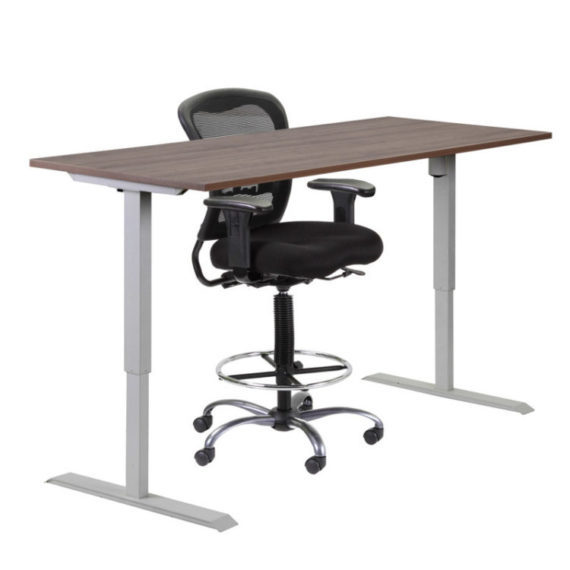Should a company or individual consider investing in a sit/stand option for a work environment?
Did you know? A study conducted by researchers at Texas A&M Health Science Center School of Public Health found that workers who used a standing desk option were 46% more productive in their work (1). And, according to the British Journal of Sports Medicine, people should be standing for at least two hours of the eight hour work day (2). Most ergonomists agree that the standing work position should be about 25% of your in-office time. But, before you start making plans for a total office makeover, remember, that an estimated 75% of your remaining time at work takes place sitting.
A common error that we furniture folks run into is when a standing desk takes priority in a work space and comprises the ergonomics of one’s sitting time. For example, when a company or individual uses a standing desk that converts to a sitting desk the dimensions are altered and the positioning of one’s arms to the keyboard and one’s neckline to the computer screen create a less than ideal ergonomic work environment.
So, whether you are standing or sitting, here are a few tips to remember:
Monitors
The monitor height is often one of those things that needs some adjusting. Whether sitting or standing, we find that monitors are often placed too low to be ergonomically beneficial; but, here is an easy way to determine what height is right for you! Sitting or standing, check that your chin is leveled with the monitor just as you would speak to someone face to face (Whoa! This is getting personal!). Now, check that your chin is parallel to the ground to prevent your neck and shoulders from bending and rolling forward. Note that bending forward while sitting moves your back away from the back support of the chair and causes a less than ideal posture when standing.
Keyboards
When working at a workstation, check that you are not lifting your shoulders and arms while you are typing away. For sitting positions, keyboards can be added to the underside of a work surface to ensure a better ergonomic typing and mousing solution. Here’s another tip. (Quick! Write this down!) If you place your hands on your thighs then lift your hands up to your desk surface, you will soon feel the need for your arms to be supported. But, if the keyboard and mouse are placed at a lower position then your shoulders and arms will not feel strained. This same logic can be applied to standing desks as well. Placing height riser products on the desk also negatively impact one’s ergonomic sitting because it could raise your keyboard to 31 inches or higher while the average desk is about 29 – 30 inches, which means your arms and shoulders will need to be lifted in order to type.
Anti-Fatigue Standing Mats
Another consideration is the kind of shoes that employees or an individual would be wearing at a standing desk (because standing for 2 hours in uncomfortable shoes might not exactly be the most friendly thing you could do to your feet, ouch!) Look out for standing mats, similar to those you would find at a grocery store check out, that would be beneficial for those longer standing periods. These mats provide a softness and buoyancy that reduce the stress that often accumulates in the back, hips, knees and ankles while standing for long periods of time.
Our conclusion
Standing desks are a great addition to a work environment IF it does not compromise the rest of your sitting work time needs AND as long as your standing desk meets the other ergonomic goals discussed above. The best solution is to utilize a fully adjustable table and attach an articulating keyboard underneath so that your keyboard and mouse are located at a lower height. Also, remember to use an articulating monitor holder so that your monitor will sit at the correct height and distance.
So the answer to the question of whether to sit or to stand. Do both.
1.http://www.chicagotribune.com/business/careers/ijustworkhere/ct-huppke-work-advice-standing-desks-0529-biz-20160526-column.html
2.https://www.washingtonpost.com/news/wonk/wp/2015/06/02/medical-researchers-have-figured-out-how-much-time-is-okay-to-spend-sitting-each-day/?utm_term=.807f51c560b4


